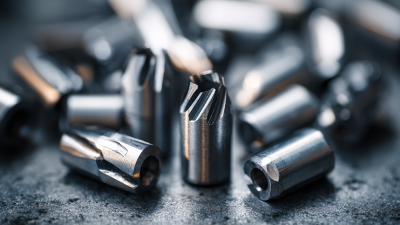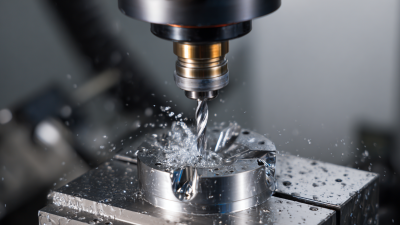How to Choose the Right Carbide Peeling Insert for Your Machining Needs
Table of Contents
- Understanding the Different Types of Carbide Peeling Inserts Available
- Key Factors to Consider When Selecting Carbide Peeling Inserts
- Matching Carbide Insert Geometry to Your Machining Application
- Evaluating Coatings and Materials for Enhanced Performance
- Cost-Effectiveness: Balancing Quality and Price in Insert Selection
- Maintenance Tips to Extend the Life of Your Carbide Peeling Inserts
- FAQS
- Conclusion
- Related Posts
Picking the right Carbide Peeling Insert for your machining projects isn't just about ticking boxes — it's really about understanding what your specific needs are. You see, these inserts are a big deal in CNC machining because they’re not only tough but also precise, no matter what material you’re working with. Here in China, Jinan Terry CNC Tool Limited Company stands out as a top player, offering a super broad selection of high-quality inserts that tackle all kinds of machining challenges. This guide’s gonna walk you through some key points — stuff like the shape of the insert, coating options, and whether it plays nice with different machines. The goal? Help you make smarter choices that boost your productivity and save you some bucks along the way. When you really get a handle on these details, you’ll feel confident picking out the perfect Carbide Peeling Insert that lines up with your goals and gets the job done right.

Understanding the Different Types of Carbide Peeling Inserts Available
When you're trying to pick the right carbide peeling insert for your machining project, it’s really important to get a good handle on all the different options out there. Carbine peeling inserts come in a few main types, each suited for specific materials and jobs. For example, you’ve got your standard inserts—they’re pretty versatile and can handle a bunch of different machining tasks. Then there are the high-performance ones, which are perfect when you're dealing with tougher conditions; they tend to last longer and resist wear better.
You’ll also come across coated inserts. These have a layer of stuff like titanium nitride or aluminum oxide on them, which actually helps them last longer and slide more smoothly, especially at higher speeds. And don’t forget about special inserts made for particular materials—like those designed just for stainless steel or even more exotic alloys. Really understanding what each type offers can make a big difference in how smoothly your machining runs and how effective it is overall.
Key Factors to Consider When Selecting Carbide Peeling Inserts
So, when you're trying to pick the right carbide peeling insert for your machining project, there are a few things you really want to keep in mind. First off, think about what material you'll be working with. Different materials call for different grades of carbide to get the job done efficiently and to make sure the tool lasts. For example, if you're working with really hard stuff, you'll probably need a tougher insert that can handle those cutting forces. On the flip side, softer materials might work better with inserts designed for a smoother finish.
Another thing to consider is the shape and angles of the insert itself. These actual geometry details—like the cutting angles—can really impact how well it cuts and how the chips are formed. To get the best results, it’s a good idea to match the insert design with your specific machining needs. Oh, and don’t forget about the coating on the insert! A good coating can boost its resistance to wear and cut down on friction, which not only makes the tool last longer but also improves your overall process.
Tip 1: Always check the manufacturer’s specs and data sheets—that way, you can make sure you’re choosing the right insert for your machine and the cutting conditions.
Tip 2: It’s wise to test out a few different inserts on some prototypes before buying in bulk. This can save you a lot of cash and also help you get the most out of your machining setup.
Matching Carbide Insert Geometry to Your Machining Application
When you're choosing a carbide peeling insert for your machining work, it’s really important to match the insert’s shape and design with your specific project. Different geometries come with their own perks — like better chip control, easier chip breaking, or just making your tool last longer. For instance, a positive rake angle might help you cut more efficiently on softer materials, whereas a negative rake could give you more stability when you're working with tougher stuff. Knowing factors like the type of workpiece, your cutting speed, and how deep you’re cutting makes a big difference in picking the right geometry to get the best performance.
Lately, things have gotten a bit more complicated with all the new tech coming out. Manufacturers are blending coatings, substrate materials, and geometries to come up with more versatile solutions. For example, better coatings can make inserts more resistant to wear, which means they hold up better in high-stress situations. When it comes to tasks like parting or grooving, choosing an insert geometry that suits the job not only saves you money but also leads to higher quality parts. Staying up-to-date with the latest in tooling tech can really help you make smarter choices — ultimately, boosting productivity and keeping your machining efficient and effective.
Evaluating Coatings and Materials for Enhanced Performance
When you're picking out a carbide peeling insert, it’s super helpful to get a good grasp of the coatings and materials involved. Honestly, the right coatings can make a big difference in how long your tools last and how smoothly your machining goes. There are different coatings designed to handle specific conditions—like dealing with high temperatures or tough, abrasive materials. For example, titanium carbonitride (TiCN) is pretty awesome because it’s hard and stable even when it gets hot, so it’s perfect for working with tough stuff. On the other hand, if you're working with non-ferrous metals, a polycrystalline diamond (PCD) coating might be your best buddy, giving you a better finish and making the tool last way longer.
Quick tip: Always think about what your project really calls for. If you’re tackling aggressive, hard-to-cut materials, opting for a harder coating could save you a lot of trouble down the line by reducing wear and tear. And don’t forget—make sure the shape of the insert matches the coating, because these things work together to give you the best performance.
Getting the substrate material right is just as important. Tungsten carbide, for instance, can boost toughness and help your inserts resist breaking, especially when you're dealing with heavy cuts. Meanwhile, polycrystalline inserts are great if you’re running a high-volume operation—they tend to wear less and last longer.
Another tip: Think about whether you need more toughness or better wear resistance for your specific task. Sometimes, trying out different combos of coatings and substrate materials can really pay off—you might stumble upon the perfect setup that helps you work faster, better, and with fewer interruptions.

Cost-Effectiveness: Balancing Quality and Price in Insert Selection
When you're choosing carbide peeling inserts for your machining projects, thinking about cost-effectiveness is super important. After all, you want to get the best results without breaking the bank. Finding that sweet spot between quality and price really depends on what you're working on—stuff like what material you're cutting, the tolerances you need, and how much you’re producing. Sometimes, investing in premium inserts pays off because they last longer and give you better performance, which means fewer replacements and consistent results over time. It’s kinda like, you spend a little more upfront, but it saves you headaches and money in the long run.
On the flip side, going for cheaper inserts might look like a smart move at first, but they can wear out faster and might not work as well, leading to more downtime and possibly higher costs down the line. So, it’s really about weighing your options and figuring out what kind of return on investment makes sense for you. By comparing different carbide grades, shapes, and coatings, you can make smarter choices that fit your budget but still give you the performance you need. At the end of the day, nailing that balance is what keeps your machining running smoothly and efficiently.

Maintenance Tips to Extend the Life of Your Carbide Peeling Inserts
Keeping your carbide peeling inserts in good shape really comes down to regular, thorough maintenance — it’s kind of a no-brainer. From what I’ve seen and read, sticking to proper care routines can actually boost the lifespan of your tools by up to 40%. That’s a pretty big deal if you’re looking to cut down on machining costs, right? One simple but important tip: make sure you clean those inserts often to get rid of chips and debris. If you ignore this, it could cause premature wear and tear. Also, using the right coolant makes a difference — not only does it help with chip removal, but it also keeps the tool cooler, which helps it last longer.
And don’t forget to keep an eye on your cutting conditions. Experts say that sticking to the recommended speeds, feeds, and depth of cut doesn’t just make your machining run smoother — it also minimizes the risk of damaging your inserts. For example, maintaining the right cutting speed can give you a cleaner surface finish and put less stress on the tool. Taking a little extra time for these maintenance steps really pays off — it keeps your carbide inserts working well and makes your whole machining process more efficient in the long run.
Comparison of Carbide Peeling Inserts Performance
This chart illustrates the performance of different carbide peeling inserts based on average life span and cutting efficiency. Selecting the right insert can significantly impact machining results.
FAQS
: Aligning carbide insert geometry with specific machining applications is crucial as different geometries offer unique advantages such as enhanced chip control, chip breaking, and improved tool life.
A positive rake angle can enhance cutting efficiency for softer materials, while a negative rake angle provides better stability when machining tougher materials.
Key factors include the workpiece material, cutting speed, and depth of cut, which collectively guide the selection of the right geometry to optimize machining performance.
Recent advancements have introduced various combinations of coatings, substrates, and geometries, making it essential for manufacturers and users to stay informed and choose the optimal solutions for their specific needs.
Coatings like titanium carbonitride (TiCN) and polycrystalline diamond (PCD) enhance insert performance by providing features such as improved hardness, thermal stability, and longer tool life, depending on the machining conditions.
The choice of substrate material, such as tungsten carbide or polycrystalline inserts, should consider the needed toughness and wear resistance to handle specific machining loads effectively.
Experimenting with different combinations of coatings and substrates can lead to discovering an optimal setup that boosts productivity and reduces downtime in machining operations.
Staying informed about the latest trends and innovations in tooling technology can help you make better decisions that maximize productivity and efficiency in your machining processes.
For aggressive materials, a harder coating may be necessary to reduce wear and improve tool longevity, along with ensuring that the insert's geometry complements the chosen coating.
Conclusion
When you're picking out the right carbide peeling insert for your machining project, it’s really important to get a handle on the different types out there. Things like what kind of machining you’re doing, the shape of the insert, and the coatings and materials used can totally influence how well it performs. Taking these factors into account can help you pick an insert that not only speeds up your work but also lasts longer and cuts down on maintenance costs.
And let’s not forget about value for money — it’s a big deal when choosing inserts. Finding that sweet spot between quality and price can make a huge difference. If you take a bit of time to weigh these key points, you’ll be able to get the most out of your tools without breaking the bank. At Jinan Terry CNC Tool Limited Company, they’re all about offering top-notch CNC cutting tools, including a wide variety of carbide peeling inserts made to handle all sorts of machining needs.
Related Posts
-

How to Choose the Best Carbide Insert for Aluminum Machining
-

Ultimate Guide to Choosing the Right Carbide Cutting Inserts for Your Projects
-

7 Best Tips to Maximize the Efficiency of Carbide Tool Inserts
-

7 Unique Features of Stone Cutting Inserts You Should Know
-

How to Select the Best Cnc Indexable Carbide Inserts Wnmg for Your Machining Needs
-

How to Choose the Best High Qualiti Insert for Your Project
Blog Tags:

Ethan
-

Phone
-

E-mail
-

Skype
